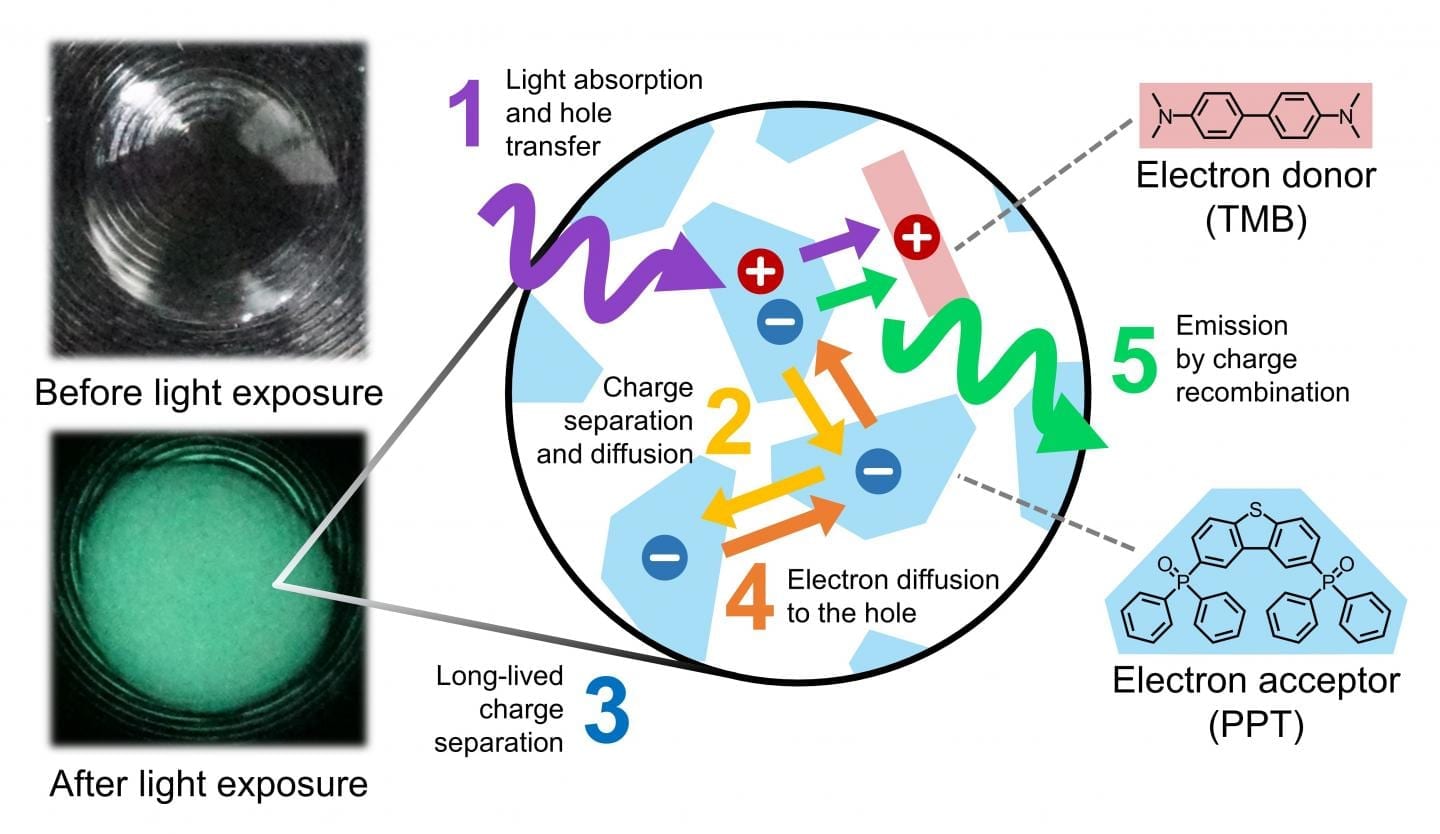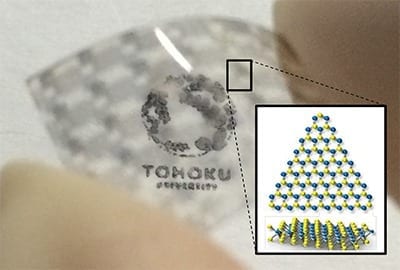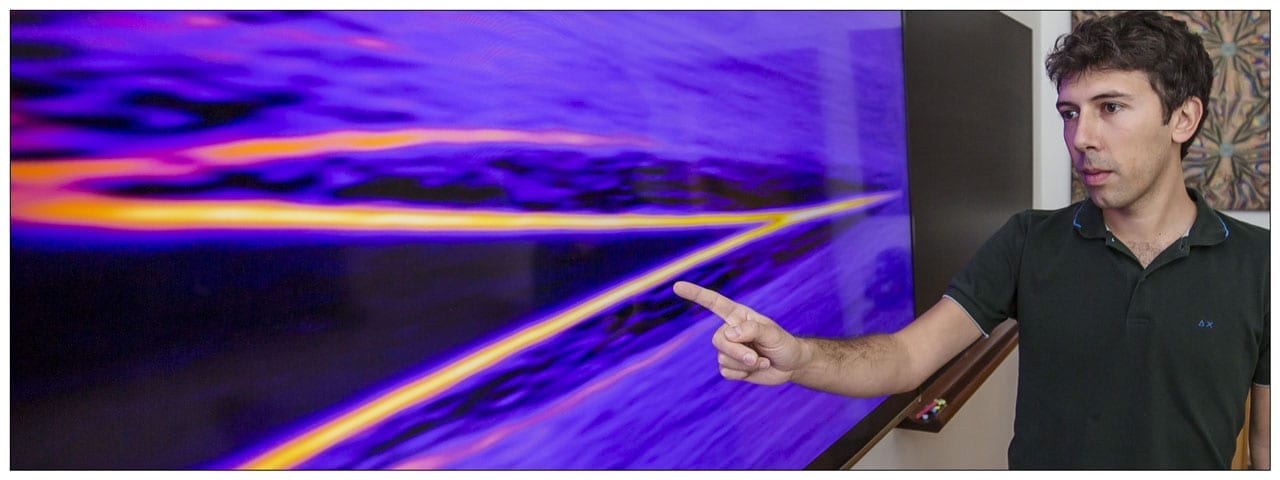
The process starts when an acceptor absorbs incident light energy, leading to the transfer of a positive charge, or hole, from the electron acceptor to an electron donor (1). The additional negative charge, or electron, on the acceptor then separates from the hole by hopping among other acceptors (2). The energy is now stored across a spatially separated electron and hole (3). The electron eventually moves back toward the hole (4), and light is emitted when the two come together (5). Some charges recombine quickly, but many can remain stored in the charge separated state for a long time (3), which leads to the glowing emission long after the excitation light is turned off.
CREDIT
Ryota Kabe and William J. Potscavage Jr.
World’s first demonstration of persistent luminescence from organic materials set to unlock new and expanded uses for the glow-in-the-dark phenomenon
Glow-in-the-dark paints that have improved flexibility and transparency while also being cheaper and easier to manufacture are on the horizon courtesy of new research from Kyushu University. In a groundbreaking demonstration, light emission lasting more than one hour was achieved from organic materials, which are also promising for unlocking new applications such as in bio-imaging.
Based on a process called persistent luminescence, glow-in-the-dark materials work by slowly releasing energy absorbed from ambient light. Used in watches and emergency signs, commercial glow-in-the-dark materials are based on inorganic compounds and include rare metals such as europium and dysprosium. However, these materials are expensive, require high temperatures to manufacture, and scatter light–as opposed to being transparent–when ground into powders for paints.
Carbon-based organic materials–similar to those used in plastics and pigments–can overcome many of these disadvantages. They can be excellent emitters and are already widely used in organic light-emitting diodes (OLEDs). But achieving long-lived emission has been difficult, and the longest emission from organics under indoor lighting at room temperature was, until now, only a few minutes.
Researchers at Kyushu University’s Center for Organic Photonics and Electronics Research (OPERA) have now broken through this limit using simple mixtures of two appropriate molecules. In films formed by melting together molecules that donate electrons and ones that accept electrons, emission lasting for over an hour was demonstrated for the first time from organic materials without the need for intense light sources or low temperatures.
“Many organic materials can use energy absorbed from light to emit light of a different color, but this emission is generally fast because the energy is stored directly on the molecule that produces the emission,” says Ryota Kabe, lead author on the paper reporting these new findings.
“By contrast, our mixtures store the energy in electrical charges separated over a longer distance. This additional step allows us to greatly slow down the release of the energy as light, thereby achieving the glow-in-the-dark effect.”
In the mixtures, absorption of light by an electron-accepting molecule, or acceptor, gives the molecule extra energy that it can use to remove an electron from an electron-donating molecule, or donor. This transfer of an electron is effectively the same as a positive charge being transferred from the acceptor to the donor.
The extra electron on the acceptor can then hop to other acceptors and move away from the positively charged donor, resulting in separation of the charges. The separated charges gradually come back together–some slowly and some more quickly–and release their energy as light over the span of almost an hour.
The mixtures and processes are similar to what are found in organic solar cells and OLEDs. After building up separated charges like in a solar cell, the charges have nowhere to escape, so they eventually comeback together to emit light like an OLED. The key difference in the newly developed mixtures is that the charges can exist in a separated state for very long periods of times.
“With organics, we have a great opportunity to reduce the cost of glow-in-the-dark materials, so the first place we expect to see an impact is large-area applications, such as glowing corridors or roadways for added safety,” says Chihaya Adachi, Director of OPERA.
“After that, we can start thinking about exploiting the versatility of organic materials to develop glow-in-the-dark fabrics and windows, or even bio-compatible probes for medical imaging.”
The first challenge to tackle on the road to practical use is the sensitivity of the process to oxygen and water. Protective barriers are already used in organic electronics and inorganic glow-in-the-dark materials, so the researchers are confident that a solution can be found. Concurrently, they are also looking into new molecular structures to increase the emission duration and efficiency as well as to change the color.
With efforts to solve these remaining issues underway, a new wave of glow-in-the-dark materials based on organics look poised to invigorate the area and expand their applications.
Learn more: Glowing news for organic materials
The Latest on: Persistent luminescence
[google_news title=”” keyword=”Persistent luminescence” num_posts=”10″ blurb_length=”0″ show_thumb=”left”]- As border debate shifts right, Sen. Alex Padilla emerges as persistent counterforce for immigrantson April 30, 2024 at 10:49 am
The son of Mexican immigrants and first Latino to represent his state in the Senate, Padilla has emerged as a persistent force at a time when Democrats are increasingly focused on border security ...
- Dollar Gains on Persistent US Price Pressures and Yen Weaknesson April 26, 2024 at 2:08 pm
A decline in global bond yield today is bullish for precious metals. Also, persistent Middle East tensions are boosting demand for precious metals as a safe haven. Demand for gold as a store ...
- Seeing deal wins in AI, GenAI space: Persistenton April 24, 2024 at 10:57 am
Sandeep Kalra, CEO, Persistent Systems, said Persistent had a long history with AI going beyond the current buzzword of GenAI. (Photo source: Official Website) IT company Persistent Systems has ...
- GERD and Chronic Cough: What Is the Link?on April 23, 2024 at 5:00 pm
Occasional or persistent cough may be a sign of acid reflux and gastroesophageal reflux disease (GERD). Managing acid reflux often improves chronic cough and provides relief, unless there are ...
- Panel at Motive Summit Tells Women to Be Persistenton April 22, 2024 at 12:11 pm
NASHVILLE, Tenn. — A panel of women who have achieved success in trucking have some words of advice for women wanting to break into and move up the ladder in the historically male-dominated ...
- The SMB’s Guide to Advanced Persistent Threatson April 21, 2024 at 5:00 pm
If you think your sensitive data is safe behind anti-malware software, think again. Advanced persistent threats stealthily breach your defenses and settle in for the long haul. You know you should ...
- Persistent Announces FY2024 Revenue of $1,186Mon April 21, 2024 at 4:45 am
Revenue up 14.5% for FY24 and 3.4% Q-o-Q SANTA CLARA, Calif. and PUNE, India, April 21, 2024 /PRNewswire/ -- News Summary Persistent Systems (BSE: PERSISTENT) (NSE: PERSISTENT) today announced the ...
- 7 Best Games With A Persistent World, Rankedon April 20, 2024 at 5:00 pm
These open-world games not only give players a virtual playground to explore, but retain persistent details of their exploits between play sessions. Video games offer players incredible immersive ...
- Fed Says Persistent Inflation Is Seen as Top Financial Riskon April 19, 2024 at 1:42 pm
Higher-than-expected interest rates amid persistent inflation are perceived as the biggest threat to financial stability among market participants and observers, according to the Federal Reserve.
via Google News and Bing News









